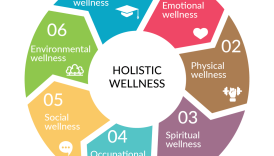The Ultimate Guide to Designing a Sustainable Healthy Life Program

Importance of Sustainable Health Programs
Sustainable health programs play a vital role in enhancing personal well-being and fostering healthier communities. Imagine a world where individuals prioritize long-term health over quick fixes. This shift not only reduces healthcare costs but also promotes resilience against chronic diseases. Key benefits include:
- The Ultimate Guide to Designing a Sustainable Healthy Life Program
- Importance of Sustainable Health Programs
- Overview of Design Process
- Setting Goals
- Defining Health Objectives
- Establishing Achievable Targets
- Nutrition Planning
- Balanced Diet Essentials
- Meal Prep and Planning Techniques
- Physical Activity
- Choosing the Right Exercises
- Building a Sustainable Fitness Routine
- Stress Management
- Recognizing Stress Triggers
- Implementing Relaxation Techniques
- Sleep Optimization
- Importance of Quality Sleep
- Creating a Restful Sleep Environment
- Mental Wellbeing
- Mindfulness and Meditation
- Seeking Professional Support
- Social Connections
- Building Supportive Relationships
- Balancing Social Interactions
- Environmental Impact
- Sustainable Living Practices
- Creating an Eco-Friendly Lifestyle
- Monitoring Progress
- Tracking Health Metrics
- Adjusting and Adapting the Program
- Long-Term Success
- Sustainable Healthy Habits
- Maintaining a Balanced Lifestyle
- Improved quality of life: Sustainable practices lead to better physical and mental health.
- Enhanced community engagement: Collective participation fosters unity and support.
Overview of Design Process
Designing a sustainable health program requires a comprehensive approach. It begins with assessing individual needs to create tailor-made strategies. For example, a community might conduct surveys to identify common health challenges. Steps in the process include:
- Defining health objectives
- Planning nutrition and fitness routines
- Establishing support systems
By following a structured design approach, anyone can embark on a journey toward a healthier, more balanced lifestyle.
Setting Goals
Defining Health Objectives
Once the design process is laid out, the next step is to establish clear health objectives. These objectives act as guiding stars for your sustainable health program. Think about what you genuinely want to achieve—perhaps you aim to lose weight, enhance endurance, or manage stress better. When defining health objectives, consider the SMART criteria:
- Specific: Clearly outline what you want.
- Measurable: Identify how you will track progress.
- Achievable: Set realistic goals.
- Relevant: Ensure they align with your overall wellness mission.
- Time-bound: Set deadlines for accountability.
Establishing Achievable Targets
With objectives defined, it’s time to set achievable targets. Break larger goals into manageable steps. For example, if your aim is to run a 5k, start by setting weekly running milestones. Strategies for setting targets include:
- Creating a timeline
- Using a journal to document progress
- Celebrating small victories along the way
By establishing clear objectives and achievable targets, you pave the way for lasting change, making your journey towards health both attainable and rewarding.
Nutrition Planning
Balanced Diet Essentials
Having set your health goals, it’s crucial to focus on nutrition planning as the next step. A balanced diet is the cornerstone of any sustainable health program. It comprises essential nutrients that fuel your body and mind. Key components of a balanced diet include:
- Fruits and Vegetables: Aim for a variety of colors to ensure diverse nutrients.
- Whole Grains: Opt for brown rice, quinoa, and oats for sustained energy.
- Lean Proteins: Incorporate chicken, fish, beans, and nuts.
- Healthy Fats: Don’t shy away from avocados, olive oil, and seeds.
Meal Prep and Planning Techniques
Once your diet essentials are defined, meal prep plays a pivotal role in success. Investing time each week can save stress and keep you on track. Tips for effective meal prep:
- Plan Menus: Create a weekly menu and shopping list.
- Batch Cooking: Prepare meals in larger quantities to save time.
- Use Containers: Invest in good storage to keep meals fresh and organized.
By embracing these nutrition planning practices, you’re better equipped to stay committed to your health journey.
Physical Activity
Choosing the Right Exercises
After nailing down your nutrition plan, it’s time to dive into physical activity. Selecting the right exercises is crucial for maintaining motivation and ensuring that your routine is effective. Consider what you enjoy—whether it’s jogging through the park, hitting the gym, or joining a dance class, choose activities that excite you. Some great exercise options include:
- Cardiovascular Workouts: Running, cycling, or swimming.
- Strength Training: Using weights or resistance bands.
- Flexibility Exercises: Yoga or Pilates to enhance mobility.
Building a Sustainable Fitness Routine
Once you’ve identified the exercises you love, the next step is crafting a sustainable fitness routine. Consistency is key! Start by scheduling workouts like appointments in your calendar. Tips for building your routine:
- Mix It Up: Alternate between different types of workouts to prevent boredom.
- Set Realistic Goals: Begin with shorter sessions, gradually increasing duration and intensity.
- Listen to Your Body: Rest when needed to avoid burnout.
By choosing the right exercises and establishing a sustainable routine, you pave the way for long-term fitness success.
Stress Management
Recognizing Stress Triggers
With a solid routine in place for physical activity, it’s essential to address another vital aspect of well-being: stress management. Understanding your stress triggers is the first step toward effective management. Perhaps certain work deadlines make you anxious, or maybe personal relationships create friction. Common stress triggers might include:
- Work Pressure: Long hours or overwhelming tasks.
- Financial Concerns: Worrying about expenses or budgeting.
- Life Changes: Moving, changing jobs, or family dynamics.
Implementing Relaxation Techniques
Once you identify your stress triggers, implementing relaxation techniques can make a world of difference. Finding methods that resonate with you is key. Here are some effective strategies:
- Deep Breathing: Take a few moments for focused breathing to center yourself.
- Mindfulness and Meditation: Dedicate time to clear your mind and achieve mental clarity.
- Physical Activity: Sometimes, a brisk walk can alleviate stress by releasing endorphins.
By recognizing your stress triggers and utilizing relaxation techniques, you set the stage for better emotional balance and resilience.
Sleep Optimization
Importance of Quality Sleep
After addressing stress management, the conversation naturally shifts to another cornerstone of health: sleep optimization. Many individuals underestimate the power of quality sleep, yet it’s essential for physical recuperation, mental clarity, and emotional balance. Benefits of quality sleep include:
- Enhanced Focus: A well-rested mind improves concentration and productivity.
- Better Mood Regulation: Lack of sleep can lead to irritability and emotional swings.
- Physical Health: Sleep supports immune function and reduces the risk of chronic diseases.
Creating a Restful Sleep Environment
To harness the benefits of quality sleep, creating a restful environment is key. This involves making adjustments to your bedroom that promote relaxation. Consider these tips:
- Minimize Light: Use blackout curtains to keep the room dark.
- Control Temperature: Keep your room cool for optimal comfort.
- Limit Noise: Consider using white noise machines or earplugs.
By prioritizing both the importance of sleep and crafting a serene sleeping space, you contribute significantly to your overall health and well-being.
Mental Wellbeing
Mindfulness and Meditation
Transitioning from sleep optimization, the next critical aspect of your holistic health journey is mental well-being. Mindfulness and meditation stand out as powerful practices to maintain a peaceful mind and enhance emotional resilience. These techniques encourage you to be present, helping to reduce anxiety and increase self-awareness. Simple mindfulness practices include:
- Mindful Breathing: Focus solely on your breath for a few minutes.
- Body Scan: Pay attention to different body parts and release tension.
- Gratitude Journaling: Write down things you’re thankful for daily.
Seeking Professional Support
While self-help techniques are invaluable, there are times when seeking professional support becomes necessary. Engaging with a therapist or counselor can provide insights and strategies that enhance your mental health journey. Benefits of professional support include:
- Personalized Guidance: Tailored strategies for your unique challenges.
- Safe Space for Expression: A confidential environment to discuss feelings.
By embracing mindfulness and recognizing when to seek help, you empower yourself on the path to comprehensive mental well-being.
Social Connections
Building Supportive Relationships
As you focus on mental well-being, it’s essential not to overlook the significance of social connections. Building supportive relationships can provide emotional support, reduce feelings of loneliness, and enhance your overall quality of life. Think about your closest friends or family—these are the people who uplift you during tough times. Ways to foster supportive relationships include:
- Regular Check-Ins: Schedule calls or coffee dates to maintain connections.
- Active Listening: Be present during conversations, showing genuine interest.
- Shared Activities: Engage in hobbies or group outings to create bonding experiences.
Balancing Social Interactions
While social interactions are important, finding balance is key. It’s easy to become overwhelmed by obligations, but ensuring you have time for yourself is crucial. Here’s how to establish that balance:
- Set Boundaries: Know when to say no to avoid overcommitting.
- Prioritize Quality Over Quantity: Focus on deepening a few key relationships rather than spreading yourself too thin.
By actively building supportive relationships and maintaining a balance, you enhance not just your social life, but your entire well-being journey.
Environmental Impact
Sustainable Living Practices
As we shift focus from social connections, it’s important to recognize how our individual health journeys intersect with environmental impact. Embracing sustainable living practices not only benefits personal well-being but also contributes to the health of our planet. Simple changes in daily habits can lead to significant positive outcomes. Here are some sustainable practices to consider:
- Reduce, Reuse, Recycle: Aim to minimize waste by repurposing items and recycling materials.
- Eat Local and Seasonal: Supporting local farmers reduces transportation emissions and ensures fresher produce.
- Conserve Water: Simple actions like fixing leaks or using water-efficient fixtures can make a difference.
Creating an Eco-Friendly Lifestyle
To deepen your commitment, creating an eco-friendly lifestyle is the next step. This involves making conscious choices that reflect your values regarding sustainability. Tips for an eco-friendly lifestyle include:
- Sustainable Transportation: Opt for biking, walking, or public transit whenever possible.
- Eco-Friendly Products: Choose organic and biodegradable products to minimize your carbon footprint.
By integrating sustainable living practices and adopting an eco-friendly mindset, you enhance not only your own well-being, but also contribute to a healthier planet for future generations.
Monitoring Progress
Tracking Health Metrics
Following your commitment to an eco-friendly lifestyle, the next essential step in your health journey is monitoring progress. Tracking health metrics allows you to gauge the effectiveness of your nutrition, exercise, and stress management strategies. By keeping tabs on your developments, you can celebrate successes and identify areas needing adjustments. Key metrics to track include:
- Physical Measurements: Weight, body measurements, and body fat percentage.
- Fitness Levels: Progress in strength, endurance, or flexibility.
- Mental Well-being: Journaling your mood or stress levels over time.
Adjusting and Adapting the Program
As you gather data, being flexible about adjusting your program is crucial. Life changes, new challenges, or unexpected successes may warrant refining your approach. Consider:
- Regular Reviews: Assess your progress monthly to stay aligned with your goals.
- Feedback Loops: Ask yourself what is working well, and where do improvements need to be made?
- Stay Open: Embrace new practices and techniques when necessary to ensure continued growth.
By continuously monitoring your progress and adapting your program, you empower yourself to stay on track toward achieving a healthier lifestyle.
Long-Term Success
Sustainable Healthy Habits
As you wrap up your journey toward a healthier lifestyle, focusing on long-term success is key. Sustainable healthy habits are the foundation of ongoing well-being. These habits aren’t just short-term fixes; they are lifestyle choices that evolve into integral parts of your daily routine. Some sustainable habits to consider:
- Consistency Over Perfection: Aim for gradual improvements rather than drastic changes.
- Meal Variety: Experiment with new recipes to keep your meals exciting and nutrient-rich.
- Regular Physical Activity: Choose activities you love to make fitness enjoyable, not a chore.
Maintaining a Balanced Lifestyle
In conjunction with healthy habits, maintaining a balanced lifestyle is essential for overall success. This means integrating physical, mental, and social health seamlessly. Strategies for balance include:
- Establish Boundaries: Prioritize time for self-care alongside social obligations.
- Continual Learning: Stay informed about health trends and practices.
- Embrace Flexibility: Allow yourself to adapt to life’s changes while staying committed to your core values.
By cultivating sustainable habits and prioritizing balance, you create a solid foundation for long-term success in your health journey.





